Driven by my participation in the “2021 Movie Draft” organized by fellow blogger hanspostcard, as the draft progresses, here are 12 movies I love by category. You can follow the draft at slicethelife.com.
FAVE DRAMA – Paterson (2016)
 Only filmmaker Jim Jarmusch could write and direct a movie about a bus driving poet and make it fascinating. Such was the subject of his 2016 movie, Paterson. While not a whole hell of a lot happens in its 118 minutes, the film is an insightful look into the satisfyingly simple life of its main character played by Adam Driver.
Only filmmaker Jim Jarmusch could write and direct a movie about a bus driving poet and make it fascinating. Such was the subject of his 2016 movie, Paterson. While not a whole hell of a lot happens in its 118 minutes, the film is an insightful look into the satisfyingly simple life of its main character played by Adam Driver.
As odd as the actor’s last name being the same as his role’s occupation, the film’s title has three distinct references. It’s the name of the film’s focus, a poetry-writing local bus driver who also lives and drives in the New Jersey town of the same name. There is also a book-length poem by New Jersey’s William Carlos Williams entitled Paterson that works its way into the story line.
Without much dialog, most of what we learn about Paterson is through observing his daily routine of waking, working and walking the dog. He peacefully follows a regular daily discipline that begins with rising before the alarm clock rings and ends with drinking a single beer at the neighborhood bar while walking the dog. (The recurring shot of the dog on a leash waiting outside the bar is priceless.) But in between, the story gets its foundation through the introspective glimpses found in the poetry he scribbles into a notebook when time permits.
In their small home, he is in a loving and caring relationship with the offbeat and creative Laura. We discover her character through her yearning to be discovered for her artistic skills of design. She also has high hopes to become a famous Nashville musician, not until of course she first learns how to play her mail order guitar. The yin and yang in the storyline develop through the contrast of Laura’s dreams with Paterson’s lack of any. He simply has no aspirations regarding the creative product of his beautiful poems. In fact, they never get any further than Laura’s ears.
Without giving the plot away, there are a few incidents that disrupt Paterson’s routine. For the most impactful one, Jarmusch brings the distress to a head in a brilliant ending that is as intellectually encapsulating as it is beautifully cinematic. The scene takes place at the Great Falls of the Passaic River which oddly sit in the middle of the city of Paterson. It’s a tranquil and peaceful setting within an otherwise dismal urban environment where Paterson gets to find rest with his predicament.
Jim Jarmusch is a remarkable filmmaker with one of the most unique movie catalogs in cinematic history. Each is brilliantly offbeat and simple in its own peculiar way. Paterson is no exception and is full of memorable scenes and side characters that Paterson meets in casual encounters. It may not be a film for everyone. Nothing blows up, no one gets killed and there’s no sex. It’s just one of the best character studies I’ve ever enjoyed on the screen.
I have watched this film several times with family and friends who are seeing it for the first time. While no one has come away totally disappointed, on the other hand, I don’t think any of them felt led like I did to make a pilgrimage to Paterson, NJ to see the Falls and some of the other locale used in the film. One of them did however put a box of Ohio Blue Tip Matches (one of Paterson’s poetic muses) in my Christmas stocking.
After seeing Paterson, I have never looked at creativity the same. While I may look at the number of “likes” I get on a blog post, the real satisfaction is taking something out of myself and putting it into words. But I will remember to back up my files.
FAVE SERIES – Barry Levinson’s “Baltimore Series”: Diner (1982) / Tin Men (1987) / Avalon (1990) / Liberty Heights (1999)
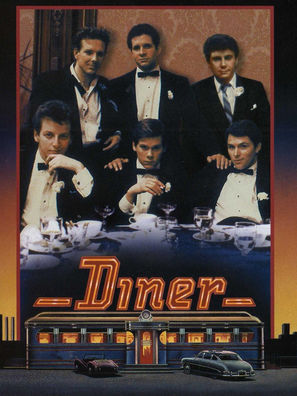
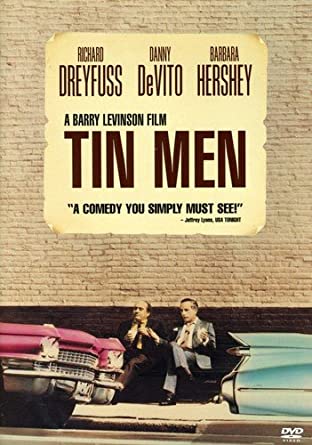
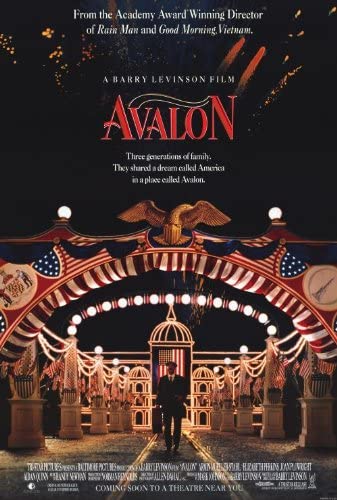
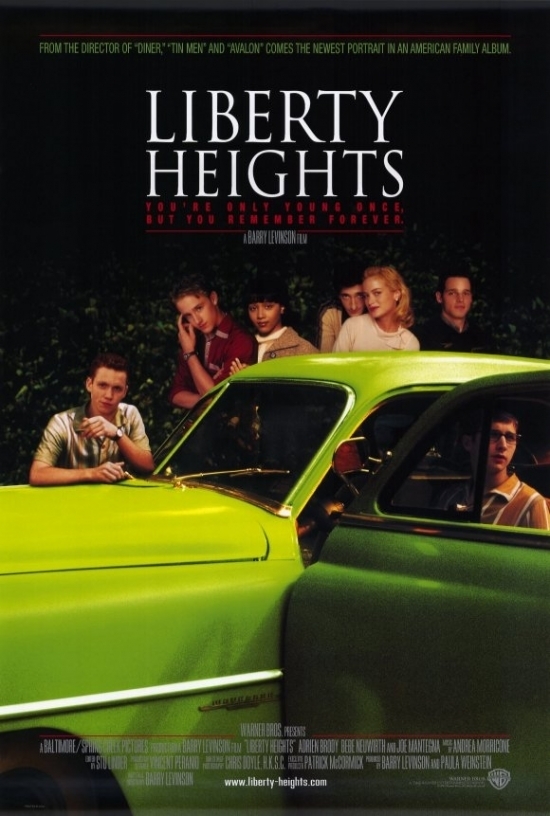
It didn’t take long to choose Diner as a film I wanted to write about. However, having already selected another movie as my Fave Drama, I was reluctant to cheapen it by labeling it as my Fave Comedy. While it sure has its funny moments, I got more out of Diner than just its laughs.
Then, a simple solution came to me. Never much one for episodic adventure series like Harry Potter, Star Wars, etc., my struggle to have to pick my Fave Series became a no brainer. Without a doubt, it would be the series of four semi-autographical films, of which Diner was the first, that Barry Levinson wrote and directed primarily about his late 50s and early 60’s childhood days in the city of Baltimore.
Levinson’s film and television resume is one of the most impressive you’ll ever find. And while these four films were not among his most commercially successful, to me they are his crowning achievement. There were 17 years between the making of the first and last films in the set, including a nine-year gap between the third and fourth. In fact, at one time the first three were prematurely released in a VHS box set labelled “The Baltimore Trilogy.”
Although Levinson is about 15 years older than me, our East Coast upbringings as a member of a European immigrant family had enough in common for his stories to resonate so well with my own youth. Most memories from these days are joyous. These times that seemed so much simpler and more family-centric than life today and these films are just chock full of heartfelt sentimental nostalgia. Even the bad things that happened in these films don’t seems so bad since we also all seemed to be more resilient back then.
Diner, likely the most popular film of the four, set the series in motion with a look at a group of young men just out of high school struggling to grow up and become adults. The connection that I have to this movie is strong for two reasons. First, visiting the local diner at 2am was a common thing to do and second, each of the yokels in this gaggle reminds me of someone I knew in real life.
Although I know you could look it up, I will spare you the wait by telling you how impressive the collection of young, then mostly unknown, actors Levinson assembled was. Get this: Steve Gutenberg, Daniel Stern, Mickey Rourke, Kevin Bacon, Timothy Daly, Ellen Barkin and Paul Reiser. Wow!
Then there are those classic scenes that always found a way to be somehow relevant to something going on in the last 38 years. The young husband-wife spat about misfiling his record albums. The football quiz about the Baltimore Colts that the young bride-to-be had to pass for the wedding to take place. The popcorn box trick with your date at the moves. And by far the best one, eating the whole left side of the diner menu at a single sitting. (“Even the chicken platter?”)
Loved by critics, Diner earned Levinson an Academy Award nomination for Best Original Screenplay.
Tin Men was next and came with the strong twin billing of Richard Dreyfuss and Danny DeVito as competing door-to-door aluminum-siding salesmen. I remember as a kid that this business had a rather sleazy reputation which Levinson works well into his storyline. These guys didn’t earn their dollars in the most honest of ways and will do just about anything to close a sale. Levinson does a great job of showing what prosperity looked like back in the late 50s with their flashy clothes and shiny cars with long tail fins.
When these two characters meet in a fender bender of their prized Cadillacs, the incident leads to an exacerbated rivalry that even goes so far as one of them messing around with the others’ wife. It was just the kind of scandalous small-town gossip that the early 60s thrived upon and woman discussed at the hairdressers. Troubles of all kinds start to happen and eventually both fall prey to justice and become friends in the end.
Music fans will get a kick out of the 80’s band Fine Young Cannibals appearing in the film and contributing to the soundtrack.
Next up was the gorgeous Avalon. Of these four films, this epic is the most cinematically majestic with memorable spectacular scenes of celebratory fireworks and tragic fires. Its story is built firmly on the importance of family and how as immigrants, they together sought to assimilate into this land called America.
Avalon looks back on a time when families kept their hometown loyalties and three generations comfortably lived under the same roof, even when success provided the opportunity for the young flock to spread their wings and leave home. And while there is so much depth to the family’s story, I find its most memorable moments are found in the simple dialog amongst the family members during the times they spent all together.
Music fans will enjoy Avalon’s Randy Newman score and Aidan Quinn and Elizabeth Perkins are brilliant in their roles as first-generation Americans. Again, Levinson received an Academy Award for Best Original Screenplay in addition to the film also getting a much-deserved nod for Best Cinematography.
The final, and perhaps least recognized film in the saga, is Liberty Heights. Among the family issues its deals with is one involving a young interracial high school romance. Considering where our world is right now, we are sadly reminded of a time when racial prejudice was much more blatant and systematic. There was an implied set of rules that you were expected to follow, and a white boy simply was not supposed to date a black girl (and vice versa).
Apart from this heavy subject matter, like Diner, Liberty Heights is lightheartedly chockfull of fun moments of kids growing up in the post-war 50s. Adrien Brody, Joe Mantegna and Bebe Neuwirth lead the cast in this one.
If there is anything that I desire to communicate through this writing, it is for each reader to be sure to watch these films. They are a brilliant collection of work that together document a precious time in American history. Like any era, there were both times good and bad. But regardless, these were the times as they were, and Levinson has preserved them beautifully. If only I could write screenplays like this about growing up in New Jersey in the 60s!
PS – Levinson later took one more look at his Baltimore days in his 2003 novel Sixty-Six. This book comes highly recommended as well.
FAVE COMEDY – Neighbors (1981)
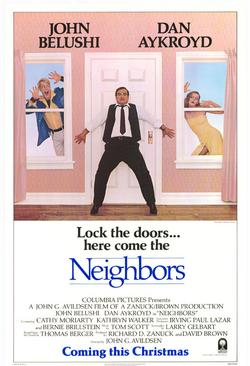 I can deal with the fact that we all won’t like the same movies. But it’s a bit more difficult when you pay good money and go to the movie theater with your wife and another couple, and they all totally hate a movie that you absolutely love.
I can deal with the fact that we all won’t like the same movies. But it’s a bit more difficult when you pay good money and go to the movie theater with your wife and another couple, and they all totally hate a movie that you absolutely love.
Such was the case in 1981 when I first saw the black comedy, Neighbors, starring John Belushi and Dan Ackroyd. This Larry Gelbart (of M*A*S*H television fame) screenplay was derived from a novel by Thomas Berger and sadly was the last time these two pals would be together on screen since it was also Belushi’s last film before his tragic untimely death. At the time it was filmed, John apparently wasn’t in a good place and it’s remarkable that it even got completed, let along deserve a mention as my all-time favorite comedy.
As far as my wife and friends’ reaction, it’s obvious that black comedy, in which humor is derived from things not normally expected to induce laughter, does not appeal to everyone. In Neighbors, most of the chuckles come from the frustrations of Belushi’s Earl Keese character’s inability to understand what in the world is going on and dealing with why everyone seems working against him.
Neighbors is not terribly dark, although there is some grief, pain, and damage. But to me, watching Keese suffer the consequences of the bizarre and mysterious behavior of his new neighbors, Vic and Ramona, played by Ackroyd and a very sexy Cathy Moriarty, was at times hysterical. And on top of that, the casual acceptance of all this oddness by his wife and daughter is anything but normal.
It’s of course unusual to see Belushi play the straight man to Ackroyd’s weirdo character, but both are just great in their parts. John looks perfectly dull and boring in his glasses and cheap three-piece suit while Dan looks quite freaky with bleach-blond hair, contacts-induced bright blue eyes and a “Born to Party” tattoo on his forearm.
What drives Neighbors is the unexplained nature of Vic and Ramona’s strange doings, how they fail to trigger his wife (played by an overly unemotional Kathryn Walker) and comically, how Earl’s reactions get him in trouble making him look like the bad guy. And of course, there is the continual sexual frustration he faces in dealing with Ramona’s surprising innuendos and advances towards him.
Most of Vic’s actions over the span of one long evening and the following day are suspect and devious. But despite destroying Earl’s safe but dull world, we find Earl on an emotional roller coaster of contempt and kinship with his new neighbor. It’s this aspect of Earls’ character that can make the viewer question whether Earl’s experience is in fact meant to be reality.
After almost 40 years, I was encouraged to finally read Berger’s novel upon which the screenplay was based. It’s a fine read and made me want to watch the film again. Gelbart remarkably stayed quite close to the original storyline although his ending is completely different. To me, the book’s ending makes a stronger case as to whether this was reality as opposed to the whole strange trip being a dream or fantasy existing only in Keese’s mind. Thankfully, both the film and book leave that for us to decide.
Watch Neighbors if you dare! Like I said, it’s not for everyone.
FAVE SPORTS FILM – Bull Durham (1988)
 I love baseball, and I love baseball movies. In picking my favorite, there were six great ones that came to mind: The Natural¸ Field of Dreams, Major League, A League of Their Own, Moneyball and my eventual pick, Bull Durham. Coming from the business world, I became intrigued with writing about Moneyball since it’s a rare look behind the scenes in the money and thinking behind how a team gets assembled. After going so far as re-watching it, before I started to write about it, I checked and saw that someone else in this movie draft beat me to it. I guess that the inside joke is that I’m a lousy GM (“general manager”).
I love baseball, and I love baseball movies. In picking my favorite, there were six great ones that came to mind: The Natural¸ Field of Dreams, Major League, A League of Their Own, Moneyball and my eventual pick, Bull Durham. Coming from the business world, I became intrigued with writing about Moneyball since it’s a rare look behind the scenes in the money and thinking behind how a team gets assembled. After going so far as re-watching it, before I started to write about it, I checked and saw that someone else in this movie draft beat me to it. I guess that the inside joke is that I’m a lousy GM (“general manager”).
I have no regrets in writing about Bull Durham, a brilliantly funny fictional tale of minor league baseball. It was written and directed by Ron Shelton, a former minor league player himself, who received an Academy Award nomination for the screenplay. Bull Durham is just one of those films so good that you are sure to get stuck for a while if you catch it while channel surfing. It also boasts several iconic scenes that contained some everlasting catch phrases. (Watch for the words “candlesticks,” “lollygaggers” and “wooly.”)
The title of the movie is a twist on the Durham Bulls, a real North Carolina team that is used as the films’ focus. Like many baseball fans, I love going to minor league games and Bull Durham captures the fun of that experience so right. While not the majors, the playing is professional, and it’s fun to be up close watching possible future stars for a lot cheaper ticket price while drinking beer and eating hot dogs.
One thing about Bull Durham, and perhaps the reason I picked it, is that it lacks the dramatic, and often cliched, come from behind victory that seems to drive many great sports films. Instead, this film just does a fabulous job of showing the lighter side of the day-to-day drudgery these players face, knowing that if just one of them on the team made the big leagues that would be a lot. They get paid peanuts, but all share a deep love for the greatest game ever invented by mankind while dreaming of someday maybe playing in the big leagues.
Bull Durham also has a great back story to its main characters that is brilliantly developed and magnificently acted by three great Hollywood stars.
The main focus in Bull Durham is Kevin Costner, the experienced and wise (in both the game and in life) but nearly washed up, career minor leaguer who earns the dubious record of most lifetime homers in the minors. He did get to play in the “show” once when the majors expanded their rosters as they do at the end of every season. There’s a great moment on the bus when he modestly tells his young teammates about “the best 21 days of his life.” By their reaction, you would have thought that he walked on the moon.
Costner as “Crash,” is contrasted with a young pitching phenom “Nuke” played by Tim Robbins. (Don’t you just love baseball nicknames?) Nuke is an immature kid with a “million-dollar arm and a five-cent head.” Having aged by baseball standards, Crash gets the job of mentoring Nuke whose foolish youth is reluctant to accept his help. They also find themselves entangled with a local legendary and eccentric baseball groupie named “Annie” played by Susan Sarandon.
The rest of the cast is top notch and comedian Robert Wuhl deserves a nod for the great role he plays as one of the coaches in contributing much to the film’s funny side.
While Bull Durham is full of enough baseball to satisfy any fan of the game, it’s also hilarious and the character development of its three stars is worthy in itself alone. And, while I hate giving stuff away, it’s nice that the movie has a happy ending for all three!
PS – Pitchers and catchers report tomorrow! Have a happy baseball season.
FAVE MUSIC MOVIE – The Last Waltz (1978)
“THIS FILM SHOULD BE PLAYED LOUD”
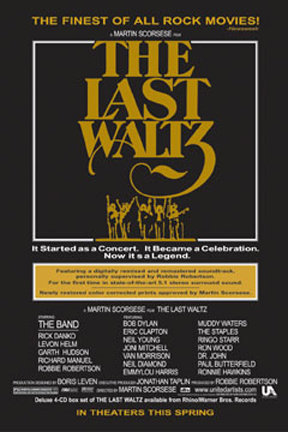 This film opens with those six words in white on a black screen. They were simple instructions possibly coming from its director, Martin Scorsese. The Last Waltz is a remarkable concert film interspersed with fresh interview segments that documents the planned final performance of The Band. And yes, it certainly deserves to be played loud. In fact, I’ve been known to make the walls in my study rattle when I crank up the volume while watching it on DVD.
This film opens with those six words in white on a black screen. They were simple instructions possibly coming from its director, Martin Scorsese. The Last Waltz is a remarkable concert film interspersed with fresh interview segments that documents the planned final performance of The Band. And yes, it certainly deserves to be played loud. In fact, I’ve been known to make the walls in my study rattle when I crank up the volume while watching it on DVD.
It’s now been over 40 years since The Band called it quits after this historic star-studded show at San Francisco’s Winterland Ballroom. And sadly, the three magnificent voices of The Band, Richard Manuel, Rick Danko and Levon Helm are no longer with us. Only guitarist-songwriter Robbie Robertson and multi-instrumentalist extraordinaire Garth Hudson remain. So, what makes this movie extra-special is that it serves as the definitive document of one of the greatest live rock bands of all time.
After six studio LPs and a long history of playing together, the guys decided to pack it in and do a special farewell Thanksgiving Day performance (November 25, 1976) and their manager, Jonathan Taplin, got Marty to make a movie about it which he shot in 35 mm film.
To this day, it surprises me about that this show didn’t sell out. Come on! The Band was still at the top of their playing form and was it really a surprise that Bob Dylan was going to be there? The price of the ticket even included a turkey dinner. I guess in those pre-internet lagging economy days, concert news wasn’t as easy to come by and folks also weren’t as likely to hop on a plane to see a show like they would today.
The guest stars for the evening included all the important folks in The Band’s history such as Dylan, Ronnie Hawkins, Paul Butterfield and Van Morrison as well as fellow Canadian contemporaries like Neil Young and Joni Mitchell. It was also cool to see Eric Clapton play with The Band since after the breakup of Cream, he sincerely asked if he could become a band member (pun intended). There was also both a Beatle (Ringo) and a Stone (Ronnie Wood) joining in on the fun. The only guest who seemed out of place was Neil Diamond whose presence was the only result of Robbie Robertson having just produced his Beautiful Noise LP.
The performances were all brilliantly filmed, and the sound quality is spectacular. Immediately, from the opening licks of their cover of Marvin Gaye’s “Baby Don’t You Do It,” you know you are in for something special and will have trouble sitting still. Yes, the guest spots are great, but to me the importance of The Last Waltz is reminding me just how great The Band was live. (Yours truly got to see the original line-up a total of seven times.)
The between-song interview bits are fun and rather than distract, they serve as nice transitions, especially when going between special guests. There are also a few special songs filmed on a soundstage which in my opinion, break the flow, and if at the time they knew what was to come, would have been better left for DVD bonus tracks instead.
There is quite a bit of legend around the filming of The Last Waltz such as squabbles among The Band members and guests, everyone having to deal with Robertson’s controlling nature and whether that really was a cocaine booger in Neil Young’s nose. I guess I could really care less, and all I have to say is if it is ever re-run in a local theater near you, go! Otherwise, buy the DVD or Blu-Ray and crank it up. Live music on film just doesn’t get any better than this.
FAVE FANTASY – The Princess Bride (1987)
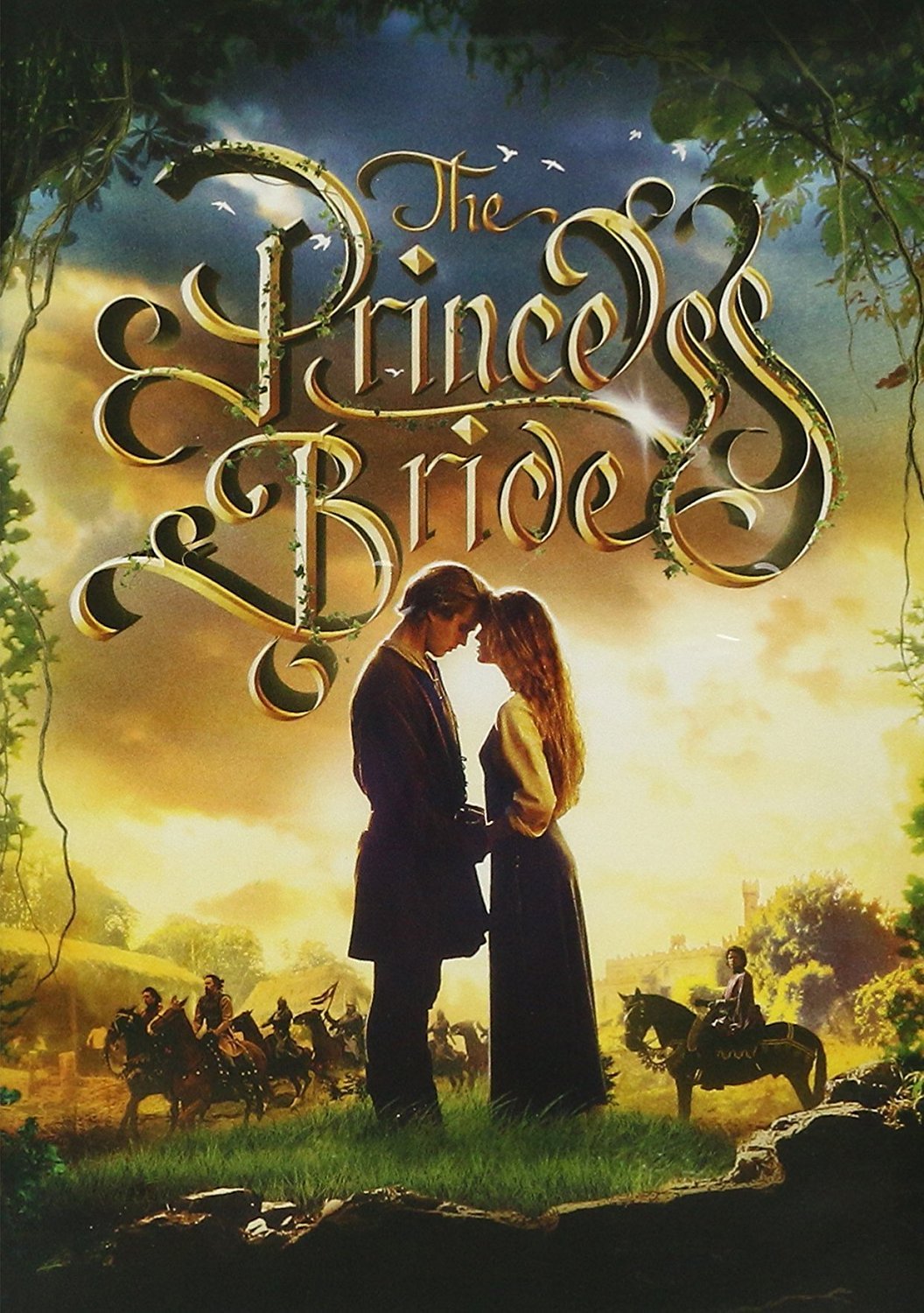 My love for fantasy films in general is best summed up by the fact that one of the best naps I ever took cost me about $12 when my family and I went to see one of the Lord of the Rings films at the movie theater. I guess I just prefer reality rather than trying to comprehend the nuances of the figments of some writer’s imagination applied to an alternative universe. And outside of my unexplained love for Star Trek, the only other fantasy film I’ve ever taken a like to, and surprisingly in a very big way, was director Rob Reiner’s delightful The Princess Bride.
My love for fantasy films in general is best summed up by the fact that one of the best naps I ever took cost me about $12 when my family and I went to see one of the Lord of the Rings films at the movie theater. I guess I just prefer reality rather than trying to comprehend the nuances of the figments of some writer’s imagination applied to an alternative universe. And outside of my unexplained love for Star Trek, the only other fantasy film I’ve ever taken a like to, and surprisingly in a very big way, was director Rob Reiner’s delightful The Princess Bride.
If I try to put my finger on why I truly love this film, I’d chalk it up to how there is just a combination of several different devices that when put together make it work for me. Not just a fantasy, it’s also a charming love story that is also full of action, suspense and most importantly, clever humor. There are also just too many brilliant cameo roles to mention although I can’t resist dropping the hysterical contributions from Bill Crystal, Carol Kane, and Peter Cook. The Princess Bride is also chockful of so many great memorable catch phrases that it’s just inconceivable!
And for me the music fan, it was such a thrill to see one of my unsung heroes get some long overdue recognition from the title track that plays over the closing credits. The song, “Storybook Love”, written and performed by the late Willy DeVille of Mink DeVille fame, was arranged by Dire Strait’s Mark Knopfler and received an Academy Award nomination for Best Original Song. (However, in keeping with the tradition of crappy songs winning this award, it lost to the dreadful one from “Dirty Dancing.”) Overall. Knopfler’s soundtrack to the film ain’t too shabby either.
Faithful to the 1973 novel it was based on, we have a true storybook love with the film’s vehicle taking the form of a loving grandpa played by Peter Falk reading a bedtime story to his endearing young grandson played by a pre-Wonder Years Fred Savage. The kid’s skeptical behavior about having to listen to a love story and how his grandpa keeps him hanging in there for the action is just too sweet for words.
The “princess” was played by a young Robin Wright in her screen debut. Her gracefully beautiful and innocent character is far from the scrupulous one she would play some 30 years later in the House of Cards television series. Her love interest was played by actor Cary Elwes who has since had a much less notable Hollywood career than Ms. Wright. He did later get to reprise the swashbuckling swordplay he learned for this film by later playing Robin Hood in the Mel Brooks spoof of this legendary hero.
I’ve also got to give a thumbs up to the great roles played by Mandy Patinkin and his on-screen nemesis, the “six-fingered” Christopher Guest. And how could you not love a film that features the cuddly Andre the Giant!
Just like the story within its story, The Princess Bride is a timeless tale that I believe will be loved by generations to come. Watch it and play it for you kids and your grandkids. It’s one of those great films that has something for everybody. A classic for the ages indeed!
As you wish.
FAVE CRIME FILM – Pulp Fiction (1994)
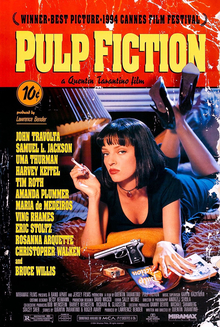 An antihero or antiheroine is a main character in a story who lacks conventional heroic qualities and attributes such as idealism, courage, and morality.
An antihero or antiheroine is a main character in a story who lacks conventional heroic qualities and attributes such as idealism, courage, and morality.
Why do we all, me included, love crime movies where we find ourselves on the side of the bad guys? Quentin Tarantino’s films serve as prime examples, especially his 1994 classic Pulp Fiction. The closing scene of this film even finds us rooting for the Bible-quoting bad guy played by Samuel Jackson over the hapless bad guy played by Tim Roth.
The film takes its title from the cheap (in both price and content) fiction magazines that were popular in the first half of the last century. Written and directed by Tarantino, it’s a dark comedic crime film composed of three interrelated stories that certainly is not for the weak. (Although it is tame when compared to Q’s previous flick, Reservoir Dogs.) In fact, I got a flavor for Pulp Fiction’s effect on viewers when I saw it on its first run in the movie theater.
I was in Chicago on business and went to see it at a theater with an actual place in crime history, the Biograph. It was there where the notorious John Dillinger was shot dead by the FBI after being tipped off by the “Lady in Red” after he ironically watched a gangster movie. On my night there, it didn’t take long for about a dozen or so patrons to abruptly walk out of the theater after Pulp Fiction’s first violent scene.
But it seems that with Tarantino’s work, most of us are willing to put up with some gruesomeness in exchange for savoring some classic black humor and clever witty dialog from his usual all-star cast.
The Samuel Jackson part is brilliant in contrasting his God-fearing righteousness with his profession as a hitman. His partner-in-crime is played by John Travolta whose career-rebounding role presents as interesting a contrast through his self-perceived worldliness. I’d give this pair the award for the best antihero duo since Bonnie and Clyde. Their conversations with one another are perhaps the movie’s most memorable feature.
The segment featuring Bruce Willis (at the time, a big Hollywood calling card) as a devious low-class boxer is also classic. And as far as outstanding cameo roles, there are just far too many to mention although the top prize must go to Harvey Keitel’s “Winston Wolfe” character with Uma Thurman’s mobster girlfriend role in a close second place.
Another attraction to Tarantino’s films is of course the musical soundtrack and he once again puts together a fine assortment of somewhat obscure older Rock songs, some of which, like Dick Dale’s rendition of “Misirlou” which plays during the opening credits, becoming forever linked to the film.
Like I said, there are some violent parts that are tough to take. But in the end, there’s so much great acting and clever scenes to enjoy, that after seeing this film, you will forever find yourself revisiting your favorites on YouTube. For me, it will always be watching the “problem-solving” Winston Wolfe in action.
For their efforts on the film, Tarantino and his co-writer Roger Avary shared the Academy Award for Best Original Screenplay. I guess I will always be somewhat perplexed about how Hollywood portrays violence and antiheroes. Nonetheless, I find myself watching and stand guilty as charged.
FAVE BIOGRAPHY – The Buddy Holly Story (1978)
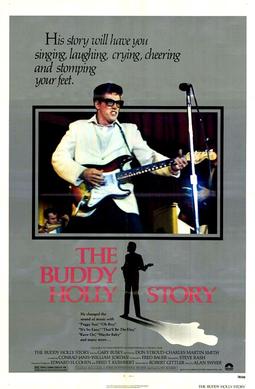 When it comes to learning about some famous person’s life through book or film, my passion for biographies lies with those about rock musicians. And while there are many, many great books to read, films on the other hand have been for the most part rather disappointing.
When it comes to learning about some famous person’s life through book or film, my passion for biographies lies with those about rock musicians. And while there are many, many great books to read, films on the other hand have been for the most part rather disappointing.
Let’s face it. There are some truly awful rock biopics. Oliver Stone’s bizarre take on Jim Morrison in The Doors, the miscasting of Joaquin Phoenix as Johnny Cash in Walk the Line and the total nonsense of the Dylan flick I’m Not There, make for three of the biggest klunkers.
But, despite having to overcome fact that actor Gary Busey had a physique that did not quite resemble his real-life subject matter, The Buddy Holly Story turned out to be the rare exception. While losing 32 pounds and donning his trademark black hornrims wasn’t quite enough to make him totally convincing as Holly, his singing and performing as Buddy was good enough to make the film a huge success and earn him a Best Actor nomination from the Academy.
In fact, so good a musician was Busey, yours truly had the pleasure of seeing him perform on two consecutive nights with Bruce Springsteen and the E Street in Philadelphia for encores of Holly’s “Rave On.” It was pure hysteria for 20,000 fans of the Boss.
Buddy Holly died when I was just three years old and it wasn’t until I was a teenager before I discovered his musical legacy. I remember reading a story about the Grateful Dead titled “Buddy Holly in Reverse” not having a clue who he was. I learned fast just how important and influential he was.
Buddy’s fast rise to fame, the depth of his catalog in his short career and his promising musical future cut short, all made his story ripe for the big screen. For the most part, the film sticks to the truth which is one of the keys to its success. Only music nerds will point out some of the factual omissions, and of course there is some unavoidable overdone Hollywood drama. But, in the end it is such a wonderful tale right up to the tragic ending that Don McLean called “the day the music died” in his song “American Pie.”
And to get to spend two hours with the great songs of Buddy Holly! The Academy liked this as well, giving the film the award for Best Original Song Score.
Years later in 1987, another great rock biopic, La Bamba, came upon us with a look at the life of Ritchie Valens, who was on the plane that fateful night with Holly. In that film’s final scene, we see Buddy Holly portrayed by singer-songwriter Marshall Crenshaw who unlike Busey, really looked like Holly. Still, I don’t think that anyone could have captured the life and charisma of Buddy Holly the way that Gary Busey did.
I was really saddened to read that neither Buddy’s widow, Maria Elana nor the owner of the Buddy Holly catalog, Paul McCartney, did not care for the movie. In the case of Maria Elana, that’s a shame since the love story between her and Buddy was presented so beautifully in the film. I guess to each his own, but I’m ready to watch this movie over and over again and celebrate one of rock’s true legends.
FAVE ROMANCE – Music and Lyrics (2007)
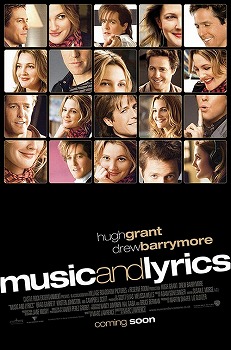 Let’s start with the fact that romantic films are not my favorite film genre. However, as an equitable husband, my marriage has led me to watch many in return for viewing together the occasional sports flick or music bio. And even though most romance movies fall into a way too predictable pattern full of cliché plots and moments, there have been a few, mostly with a comedic element (“Rom-Coms”), that I have enjoyed. When searching the depths of my aging brain for what romance film I would consider to be my favorite, two with a common actress, but different enjoyable themes came to mind.
Let’s start with the fact that romantic films are not my favorite film genre. However, as an equitable husband, my marriage has led me to watch many in return for viewing together the occasional sports flick or music bio. And even though most romance movies fall into a way too predictable pattern full of cliché plots and moments, there have been a few, mostly with a comedic element (“Rom-Coms”), that I have enjoyed. When searching the depths of my aging brain for what romance film I would consider to be my favorite, two with a common actress, but different enjoyable themes came to mind.
I’ve long had a not-so-secret crush on Drew Barrymore. In fact, my wife loves to joke about it more than it deserves. Crush aside, I also think she is a fine actress who proudly carries on her family tradition. But it takes a bit more to hook me into a romance film. There are two featuring her that “drew” me in due to my love of baseball (and my fave author Nick Hornby) for Fever Pitch and my love of music in the choice for my fave pick, 2007’s Music and Lyrics.
A major attraction to this film for me is the perceived idyllic lifestyle of the film’s lead character, Alex, played by Hugh Grant. It’s also one that I first fantasized about after seeing Dudley Moore’s character in the move 10. I just thought that working out of your home as a songwriter was about the coolest thing a person could ever do for a living. And in the case of Grant’s role, he does it out of a stylish Manhattan apartment to boot!
There’s no doubt that this flick belongs in the Rom-Com sub-genre since styling Alex after Andrew Ridgely in the Brit band Wham was pure genius. Alex’s character mirrors Ridgeley in that he wasn’t his band’s much more popular and famous George Michael. Nonetheless, Alex, who’s band was called “Pop!” and whose big hit was the syrupy, “Pop! Goes My Heart,” comically and sadly still plays the occasional cheesy solo concert at state fairs and theme parks for his dwindling fan base of aging and adoring soccer moms. Grant even does his own singing in the movie and isn’t that bad!
Given a rushed songwriting assignment to hopefully salvage his sagging career, Alex struggles with his skills as a lyricist until he meets Drew’s character, the somewhat unsettled Sophie. He discovers her when she covers for a friend who takes care of his penthouse plants. While Alex can write the “music,” he is lost for the “lyrics” which he finds in Sophie as he catches her muttering words to his piano playing while watering his greenery.
If you love Pop music like I do, you will not only love the great storyline, but you will also find that the songs in the film are brilliant. The lead song in the film is the gorgeous “Way Back into Love” penned by the late great Adam Schlesinger from the band Fountains of Wayne. Long one of music heroes, Adam is no stranger to Hollywood having had great previous success with the great title track to The Thing That You Do. While Adam got an Academy Award nomination for “The Thing That You Do,” he got robbed for not getting a repeat nod for “Way Back into Love.”
So, without given too much away, Alex and Drew together write “Way Back into Love” for the day’s reigning nutjob musical diva played by Haley Bennett and it’s a smash success.
And, oh yeah, I almost forgot. Alex and Sophie fall in love, fall out of love, and get back together to live happily ever after! Touché cliché! But I have to admit that it was a cute love story, and I couldn’t help rooting for them.
FAVE FOREIGN/SILENT – The Artist (2011)
 With my regular blogging business focused on my loves for pizza and music, this opportunity to make “draft picks” and write about my favorite movies has been an enjoyable stretch. However, with three picks to go, I found myself struggling for selections in my remaining genres. Of those left, the Foreign or Silent choice proved the most difficult since I couldn’t even think of any that I have seen!
With my regular blogging business focused on my loves for pizza and music, this opportunity to make “draft picks” and write about my favorite movies has been an enjoyable stretch. However, with three picks to go, I found myself struggling for selections in my remaining genres. Of those left, the Foreign or Silent choice proved the most difficult since I couldn’t even think of any that I have seen!
Pouring over lists of foreign films, I was sure that something would surface that I have watched. I even began to regret that I couldn’t understand the Irish dialogue enough to make it all the way through Trainspotting since I guess it would qualify as a Foreign film. As for a Silent film, as a child, I saw my dad watch all the Charlie Chaplin classics, but I don’t think I’ve ever made it all the way through one. Let’s face it, I guess I need spoken words in English, not subtitles or dialogue intertitles, in my movies.
Discussing this dilemma with my wife, she quickly reminded me that I did enjoy the 2011 film, The Artist. As always, she was right. I did love that one but had completely forgotten about it. The Artist is styled like a classic black and white silent film and my wife and I even saw it in the fitting space of our historic hometown movie theater.
In all fairness, I was concerned when I pegged it to be my Silent film choice, since it’s technically a “part talkie” film that has some bits of sound and dialogue. But alas, I felt safe with my choice when I discovered that it is also technically a Foreign film having been produced in France.
I was also quite surprised to see that The Artist was nominated for ten Academy Awards, winning five including three of the big ones: Best Picture, Best Director and Best Actor. Rather remarkable when you think about how many filmgoers like me, also prefer color and sound on the big screen. The question remains though as to what makes the film the exception to my narrow taste?
While I don’t want to give too much away, The Artist is cleverly designed as a Silent movie about a fading Silent movie star. Set in Hollywood, the lead character’s fall is contrasted against the rise of a former co-star of his who makes the successful move into the “talkies,” a move which he is both denied and opposed to. I will however make you wait patiently and watch the film to find out when the screenplay lets the “silent” wall gets broken.
French director, Michel Hazanavicius, does a perfect job of getting everything genre correct: the proper black and white tones and aspect ratio, accompanying orchestral music (in an Award-winning score) and classic-looking dialogue intertitles. He also employed some modern film trickery to mimic how things looked on the screen back in the day. He really nailed it!
The lead role of George Valentin is played by French actor, Jean Dujardin. His on-screen presence is as emotively expressive and captivating as it took to be successful back in the Silent film era and well worthy of the honors he received for his performance. The storyline, although it reeks of “hasn’t this has been done before,” is however so well-written that it will keep you glued to the screen. Kudos also to French actress, Bérénice Bejo who, nominated for Best Supporting Actress, also gives a great performance as the rising starlet Peppy Miller. And these two really do some fabulous dancing together!
Alongside the serious looks at the “pre-talkie” fame and glamor of the film star’s life and the tragedy that follows, The Artist is humorous with both running gags (such as the charming actions of the “The Dog”) and cleverly hidden bits of sarcasm that you need to keep your eyes open for. There are also great cameo roles by three familiar actors: John Goodman (perfectly cast as a 1920’s movie bigwig), James Cromwell, and Malcom McDowell.
So, tough it up and give this one a go if you have not already done so. You will be glad that you did.
FAVE ACTION FILM – Grosse Pointe Blank (1997)
 In discussing my previous selection of Pulp Fiction as my fave Crime flick, I ruminated about the use of the antihero in film. Well, here’s another film that many of us love where we find ourselves rooting for the bad guy. In the case of Grosse Pointe Blank, it is actor John Cusack in his lead role as Martin Blank, a freelance professional hitman. Given that we all like the characters Cusack plays, he can’t be all that evil now, can he? Aside from killing people for a living, he just seems so otherwise likable and normal.
In discussing my previous selection of Pulp Fiction as my fave Crime flick, I ruminated about the use of the antihero in film. Well, here’s another film that many of us love where we find ourselves rooting for the bad guy. In the case of Grosse Pointe Blank, it is actor John Cusack in his lead role as Martin Blank, a freelance professional hitman. Given that we all like the characters Cusack plays, he can’t be all that evil now, can he? Aside from killing people for a living, he just seems so otherwise likable and normal.
Come on and admit it! You felt sorry for him in that being a paid-for-hire assassin was such a stressful occupation. And in that action-packed violent ending scene, you were pulling for him to take down and kill his nemesis, a fellow hired gun named Grocer played by Dan Aykroyd. These two were at odds over Martin not wanting to join the “hitman union” Grocer was forming.
Fascination with this flick is further driven by the behind-the-scenes look at Blank’s business. We see Marcella, his administrative assistant, played by his real-life sister Joan, making travel reservations to schedule his hits, and buying ammunition. Just normal everyday stuff. At some point, I’m sure many viewers ignored the brutality of it all and saw this as a lucrative and glamorous profession!
The normalization of this diabolical profession gets even weirder. We see Blank’s crisis of conscience further exposed when he reluctantly decides to attend his ten-year high school reunion, in of course, Grosse Point, MI. It’s funny stuff when people ask Martin what he does for a living and he tells them the truth!
While back home, he tracks down his high school sweetheart Debi, played by Minnie Driver. She also turns out to be the connection to the uncanny coincidence that drives the movie to its conclusion. (I’ll keep that one as quiet as the silencer on Martin’s gun.)
It also needs to be said, that while a great exciting movie, Grosse Pointe Blank also boasts a killer and plentiful soundtrack of songs from its period setting in the 80s. (Made easier since Debi works as a radio DJ operating out of a storefront window.) Its CD release was so well received, that they even put out a More Music from the Film follow-up release which still left another CDs worth of songs that were heard in the film. There are almost as many great songs as there are bullets fired in the action-packed final shootout scene.
Grosse Pointe Blank is clever, funny and as the category requires, plenty full of action. It also gets lovey-dovey at the end. Like me, you have probably seen it on television a dozen times, but like I feel while writing this, I am always ready to see it once more. Oh yeah, they even get to blow up a convenience store!
FAVE WESTERN FILM – True Grit (2010)
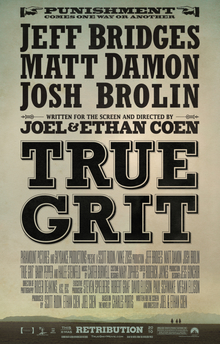 Participating in this movie draft has been a blast, and with this pick, has sadly reached its conclusion. It is certainly no surprise that I have left choosing my favorite Western or War film as my final selection. Neither genre has ever been a part of my move-watching regimen. Nonetheless, after giving you some brief background about why this is such, I will get to my choice, albeit in an around about way.
Participating in this movie draft has been a blast, and with this pick, has sadly reached its conclusion. It is certainly no surprise that I have left choosing my favorite Western or War film as my final selection. Neither genre has ever been a part of my move-watching regimen. Nonetheless, after giving you some brief background about why this is such, I will get to my choice, albeit in an around about way.
When it comes to War flicks, after seeing all the major Viet Nam war movies in the 70s and 80s, I came down to the realization that this subject was one that I’d just rather forget. One thing I didn’t forget however was the time that a co-worker and I went to see the epic The Deer Hunter while out-of-town on business. The part I remember is that neither one of us spoke a single word on our 30-minute drive back from the theater. Tough stuff. I also recently gave up after a short investment in Dunkirk after feeling the same way.
As for Westerns, plain and simple, they just don’t interest me. Growing up watching New York City television, in addition to the then three networks and PBS, there were three local stations (Channels 5, 9 and 11). I so much recall turning the dial and passing through what seemed like a countless number of Westerns on those local channels. The old ad slogan of “Don’t touch that dial” didn’t hold true for me when it came to these films that I perceived as stereotyped boredom.
So, in wrapping this series up, I found a way to make amends for failing to include a Coen Brothers film among my earlier choices. And while I certainly favor their unique spins at first-time screenplays, there was so much that I did love about their 2010 updated screenplay and directorial remake of the 1969 John Wayne classic of True Grit.
Before I get into my lovefest about Joel and Ethan Coen’s movies, here’s a thought about Westerns. As I started to play the DVD for Grit, after first navigating through several previews of 10-year old movies that never made it, I came upon the logo for its PG-13 rating. At the top of the list below the rating was the term “Western violence!” How odd that this would have a categorization of its own. This got me thinking how Western and Mobster movies are so alike in that killings are so commonplace that it makes you wonder how the people in the film have managed to survive as long as they have!
It’s hard for me to put in words what make a Coen Brothers film so magical. Perhaps it’s the fact that no one can use a camera as masterful as they can. The angles, effects and palate of their work is simply remarkable. Then of course there is the element of the bizarre unexpected scene. Avoiding spoilers, for this one let’s just say fingers, snakes and dead bodies. Then there’s the casting.
Jeff “Lebowski” Bridge just killed it in taking over Wayne’s lead role. Gosh, he was just so curmudgeonly gnarly while still somehow managing to be proficient in his less-than-desirable occupation. Another Coen-regular, Josh Brolin did justice to being a bad guy you loved to hate. And the teenage Hailee Steinfeld in her film debut was just awesome as the way smarter-than-her-years little girl. Even Matt Damon wasn’t too bad in taking over Glen Campbell’s role in the original.
True Grit received 10 Academy Award nominations including Best Picture, Best Director and Screenplay (for the Coen’s) and Actor for Bridges and Supporting Actress for Steinfeld. That great camera work that I mentioned earlier was also honored with a Best Cinematography nomination. But, for some reason, True Grit didn’t win any. Wayne won Best Actor in the 1969 original which was more focused on his story compared to the young girl’s perspective in the 2010 version.
Lack of awards withstanding, I still think the Coen remake is well worth a watch. And with it fresh on my mind, I think I will go back and watch John and Glen in the original again. If only to hear Glen sing the title song “True Grit” (not reprised in 2010) which was nominated that year for Best Song but lost to “Raindrops Keep Falling on My Head.”
